You can tell I I’ve been putting off household admin as the title of this blog is the first time I’ve written 2019 this year. Shall I pay the bills or shall I write my first Six on Saturday of the year? No contest.
My six are a mix of new beginnings, resurrections and rescues – an apt combination for January.
Amaryllis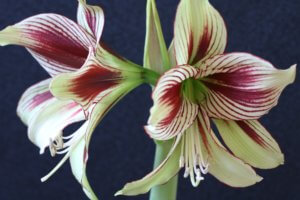
This amaryllis is called Papillo and is a stunner. I’ve grown it before and it is highly recommended for its lime green flowers streaked with burgundy. The flowers are slightly smaller then many of the blowsier amaryllis but what they lack in size, they make up for in impact. The bulbs are usually slightly more expensive than some of the commoner varieties but I think worth it.
This year I’ve had some success getting my amaryllis to re-flower by giving them a summer holiday in the garden. If this one re-flowers next year I’ll be very happy.
Alpine Seeds
I’ve mentioned before that I have become a diarist for the Alpine Garden Society, sharing my experiences as a beginner alpine grower. Before Christmas I wrote on the Alpine Garden Society website about how I made my selections from the AGS Seed Exchange – thought to be the largest exchange of its kind worldwide. If you’re interested to learn more about the seed exchange and how I navigated my first one, follow the link here.
Even more exciting than selecting my seeds was receiving them in the post. Twenty three tiny packets of promise.
As I plumped for the beginners ‘Easy Packs’ I had no idea what I would receive but I have been sent varieties with some very lovely names including Erinus alpinus ‘ Fairy Foxglove’ and Primula frondosa ‘Leafy Bird’s Eye Primrose’.
Most can be sown any time from now until April but I intend to do so soon as they can mostly be left outside in the cold, just as they would in the mountains.
Bulbs
The bulbs I planted in teracotta plans are almost all showing signs of growth. They are a mixture of crocus, miniature daffodils and Iris. One pan was broken by my son’s new remote control car – a fun Christmas present but one that is now not welcome near my pots.
I’m thinking I will put some of the pots up on my two outdoor tables so that they are beyond collision and so that the flowers can be better admired when they appear.
Snowdrops
Just before Christmas I invited my new friend the Snowdrop Man round for a mince pie and a garden tour. I have previously written about him – he is in his eighties and a self-confessed addict of what he calls “snowdroppery”.
After we polished off the mince pies we headed up to his garden nearby as it was a good day for photography. I took some great shots of three early flowering snowdrops – ‘Three Ships’, ‘Robin Hood’ and ‘Mrs Macnamara’. He was very kind and gave me a couple of pots to take away and I feel very fortunate to be able to learn more about snowdrops from someone who really knows his stuff.
Erythrinum latissima – Broad Leafed Coral Tree
Decimated by red spider mite whilst I was on my summer holiday, I wrote back in September how I had this plant indoors in my houseplant ER. It is still touch and go as whilst the plant has produced new growth it is a bit spindly for what grows as a branching tree in its native Africa.
I don’t know much about this plant or what it needs in the UK so I feel like I’m flying blindfolded with regards to its care, despite searching online for advice. As it’s a deciduous tree in its native Africa, the fact that it lost its leaves may not be entirely unexpected. I’m hoping once days are longer and temperatures warmer, its growth will become stronger.
Mealybugs
I recently discovered a few mealybugs in the heated section of my greenhouse. I used to panic at the sight of any pests, but I have learned over time to respond calmly and organically. The exception is Red Spider Mite, which appear to take little more than a few days to damage a plant irreperably so swift organic action is required when red spider mites are in town.
My experience with mealybugs is that whilst gross-looking, they are fairly benign and don’t seem to do much damage in small numbers. This week I calmly dabbed away at those I could find with some surgical spirit and a cotton wool bud.
Come spring, as the temperatures warm up I will be looking into buying more biological controls for my greenhouse, including some Cryptolaemus larvae which happily march around the leaves of a plant in search of the mealybugs.
I have used these fairly successfully in the house before and I quite enjoyed watching the tiny bugs grow from unpromising little things, barely bigger than a pin-head, to voracious mealeybug munching machines. They are the larvae of a brown and red ladybird but I never found the adults once the larvae had disappeared…
Six on Saturday is a weekly meme – take a look at the comments at the base of host The Propagator to see more ‘sixes’ from other keen gardeners from all over the world.



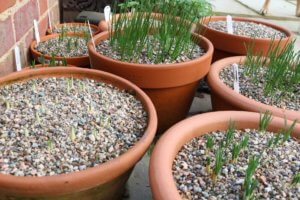
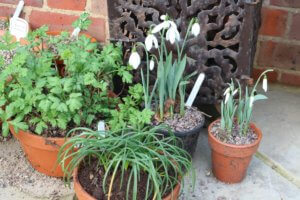
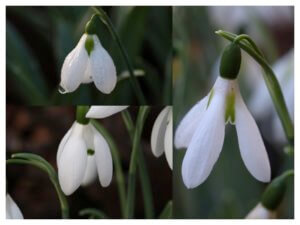
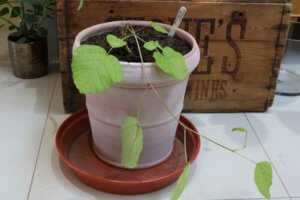
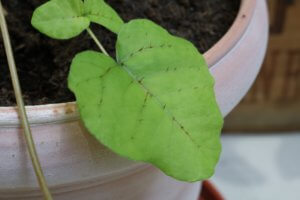
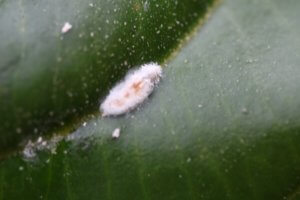
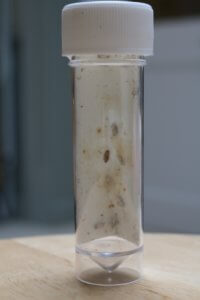

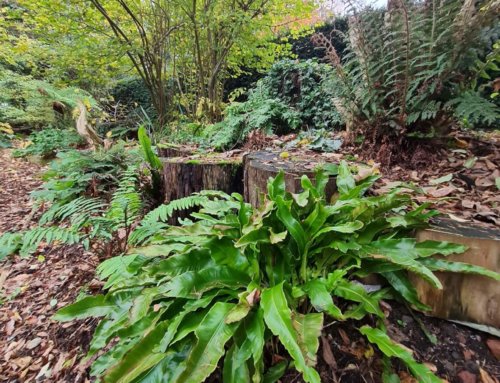

That amaryllis is indeed a stunner!!! So nice to see the sowdrops – they’re a favourite of mine, likely because my first horticultural memory is of a large patch growing at the base of our family home when I was very very young.
Snowdrops! I can barely see this early in the morning!
Hi Chris – lovely to hear from you. Like you, snowdrop bring back many childhood memories. The varieties shared here are all early flowerers given to me by a local collector. My garden patches are barely out of the ground yet.
Your pots are looking lovely and neat with the promise of bulbs to come up.
Your writing for the Alpine Garden Society sounds really interesting. Can you really just plant alpine seeds outside now and watch them come up? Do you have a dedicated alpine area? Look forward to following your progress.
First time for me for alpine seeds but yes I gather you can. If you think about it, they sit under layers of snow up in those alpine meadows and germinate come spring. Will be sure to let you know how I get on. I have a few alpie troughs and pots so far but have an area that I could devote to alpines when I get my act together.
I love Erinus alpinus. Look forward to hearing how you get on. Lovely to hear about your friend and his garden of snowdrops too.
Hi Tilly – If Erinus alpinus is a favourite of yours it must be good. I think you’re in Italy – do you ever get out to the Italian alps?
You have three great snowdrops there, particularly Galanthus ‘Mrs. mc Namara’, which has an Irish connection, and ‘ Three Ships’. I adore seeing snowdrops flowering from the earliest in October to the latest still going strong in March. I hope your collection grows over the years as it is great fun adding to them every year.
Hi Mary – I certainly hope to grow a few more of them and it’s been lovely to have such an ethusiastic friend to introduce me to some of the varieties. He’s promised to show me how to twin scale the bulbs. Are you a grower too?
Already seen on Twitter, your amaryllis is a stunner, you’re right! I love it !
I’m waiting for my snowdrops but mine are in the lawn and lack heat … My favorite is Mrs. Macnamara (right, I guess)
The last thing: I read that persimilis (Phytoseiulus persimilis) are effective against red spider mites. I’ll have to do some research on that side as well.
Yes, I think I’d read that about Persimils too. I just don’t understand how I’d keep them in the greenhouse once the vents are open and of course I’m hoping not to have so many bugs that they have a permanent food source. More research required on this aspect so I’ll definitely be speaking to the experts at the suppliers before I buy.
The amaryllis is stunning – I got a photo of some in the glasshouse at RHS Wisley some years ago as I thought they were absolutely gorgeous. Never occurred to me that you could buy them! I am guessing they need some warmth?
https://smallbluegreenflowers.wordpress.com/2016/01/01/hippeastrum/
And how pretty are those snowdrops in the pots. Hadn’t occurred to me to put some in pots. I have planted a couple of varieties under a tree in the garden, but whether they appear or not is anyone’s guess! I shall look forward to seeing how the alpines fair. Do you have a dedicated Alpine bed for them then?
Hi Jude – thanks for sharing the link to your stunning photograph – it shows the plant off beautifully, better than mine I think! I don’t think they really need too much warmth. If I buy a bulb, I pot it up and stand it on a fairly cold windowsill in a usually unheated room until the flower spike emerges. I’d say the temperature is no more than about 10-15 degrees C in there. These bullbs were from a UK supplier called Gee Tee Bulbs and it cost £6.50 – great value.
Yes the snowdrops in pots look cute and it helps to show them off for the beautiful specimens they are. My snowdrop friend sinks his pots into the ground to help regulate the temperature at the roots and prevent them drying out.
In terms of alpines, I have various pots and troughs and a few dotted in walls and crevices but I have an idea for a new rockery bed if I can get my act together.
I knew I should have planted some snowdrops! How lovely to have an expert in your neighborhood! Have you thought about interviewing him on the changes in gardening or his experiences in his garden! I would love that and think other gardeners might too!
Nice to hear from you Travel Lady. I have thought about interviewing my friend – he has so much information and enthusiasm to share. It won’t be long before you can buy snowdrops in the green to plant for next year. I’ve also noted a booming trade on ebay for rarer bulbs!
The amaryllis is certainly very special. And you’ve got me thinking about planting bulbs in pots when the time comes for me- a couple of maonths away yet.
If you know anyone who smokes, soaks some of their cigarette butts in water and feed the plants with that water. It’s a good cure for mealy bugs.
Wow – great tip about the cigarette butts. My brother is a smoker but may think I’ve gone mad if I ask him for his butts! I can definitely recommend the bulbs in pots. I’ve seen various displays in alpine houses and on social media and whilst they also look good in the garden, having a few special pots near the back door really shows them off and cheers you up come spring. Enjoy the rest of your summer there!
Seeds! I am waiting impatiently for my HPS seeds to arrive, will be back end of the month. Jealous…
It’s certainly exciting when that envelope plops through the door. I’m waiting for the children to go back to school so I can indulge in some solitary seed planting. I will relish it.